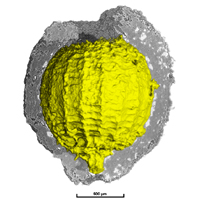
Image of a sycidium gyrogonite surrounded by its utricule.Researchers from the Université de Montpellier II (France), the Institute of Geology of China, and the ESRF have been able to identify enigmatic fossils from Devonian (about 400 million years) as fructification of charophyte algae. Charophytes are land plants living in fresh water that still exist nowadays. This breakthrough allows researchers to better understand the evolution of these very old plants of the Paleozoic era and to have an improved overview of the climate at this period. The use of powerful X-rays beams to perform high resolution microtomography at the ESRF was one of the major keys in helping to understand the internal structure of these fossils. The results of this research are published in the latest issue of the American Journal of Botany with the title "New insights into Paleozoic charophyte morphology and phylogeny".
These fossils belong to the enigmatic group of Sycidiales. Since their discovery, in 1934, no one really knew what they actually were. They had been defined as bracken "seeds", corals or even small crustacean eggs. Thanks to high resolution X-ray synchrotron microtomography on beamline ID19 at the ESRF, the team of scientists succeeded in investigating the three-dimensional structure of these fossils. The samples they used ranged from 500 micron to 4 mm and originated from all around the world. Synchrotron radiation was fundamental for this study since it revealed microscopic details of the internal anatomy of these fossils without damaging them. At present, no other techniques allowing the study of these structures in a non-destructive way are available.
Charophytes fructifications exhibit a complex evolution. They all have quite a rounded shape, but the oldest ones display vertical structures on their outside surface, while the most recent ones present spiral ones. Fossils studied during this research are from the Paleozoic (or Primary era) and show these vertical structures. What surprised the researchers was the presence of an utricule, which was known before only in some Mesozoic (secondary era) charophytes. An utricule is a supplementary protective layer believed to protect the zygote (reproductive cell) against desiccation. The fact that such a structure was acquired during the evolution of these very old algae means that they probably lived in a harsh environment. This structure could be interpreted as an adaptation to strong seasonality with dry summers leading to ephemeral aquatic environments.
The use of X-ray synchrotron microtomography for this pioneering study on fossil algae opens new doors to paleontology. Indeed, charophytes represent only one group among numerous others of very small fossils. This kind of investigation should hence become a reference for non-destructive three-dimensional approach of small fossils.
Source : European Synchrotron Radiation Facility
 Print Article
Print Article Mail to a Friend
Mail to a Friend
